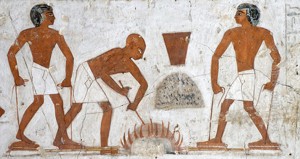
The Egyptian copper smelting process utilized a ’bowl furnace’ which was supplied additional air, to raise the temperature of the fire, through the usage of foot bellows. Malachite and azurite were used as a source ore for the copper, charcoal was used as the reducing agent to separate oxygen from the copper, and iron ore was used as the ‘flux’ to bind and float away impurities. The advantage that copper has over bone, wood, or flint, as a tool or weapon, is that when damaged it can be repaired. However, like most pure metals, i.e., metals with a low level of impurities, copper is soft. It turns out that intentionally or unintentionally adding another soft metal in small amounts can make the host material stronger and harder. This is a process known as alloying, which we will be discussing further in the next lesson.
Now let’s go to the next section and look at the soft metal, tin, that the Egyptians added to copper to produce a more durable and harder metal.